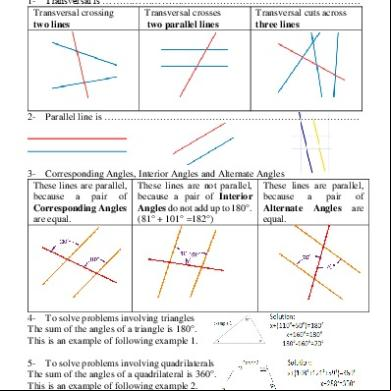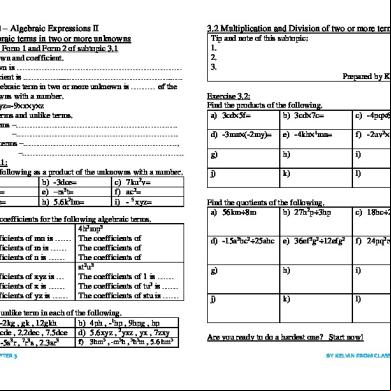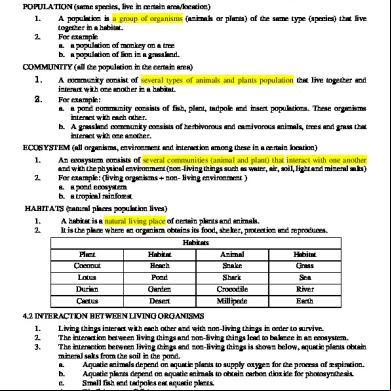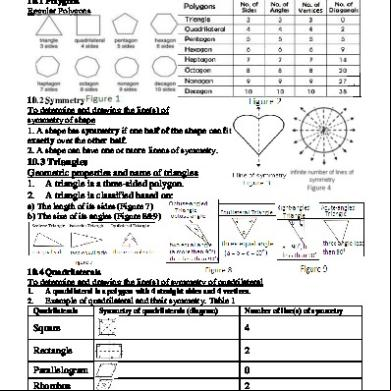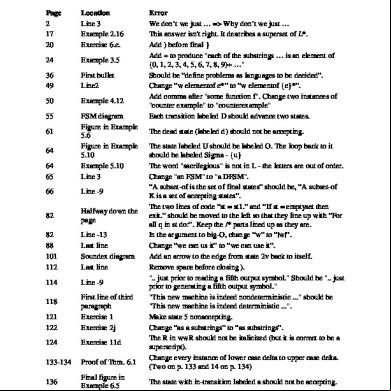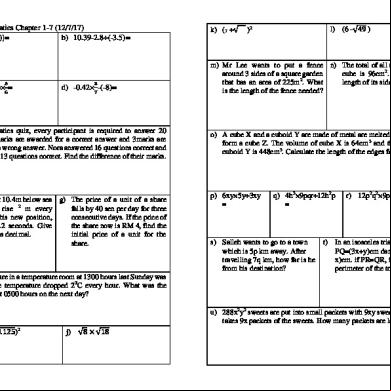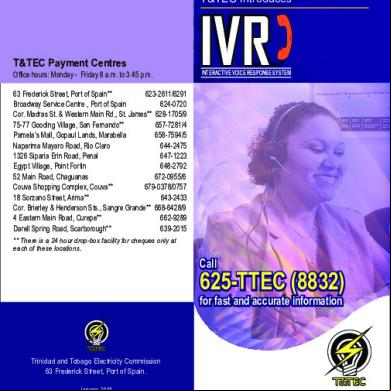This document was ed by and they confirmed that they have the permission to share it. If you are author or own the copyright of this book, please report to us by using this report form. Report 3i3n4
Overview 26281t
& View Mathematics-form 3-chapter 1, 2, 3 & 4 By Kelvin as PDF for free.
More details 6y5l6z
- Words: 1,593
- Pages: 10
Mathematics Form 3 – Chapter 1, 2, 3 & 4
© Notes Prepared by Kelvin
Form 3 – Chapter 1 - Lines and Angle II In this chapter, you will learn: 1- Transversal is …………………….……………………………………………… Transversal crossing Transversal crosses Transversal cuts across two lines two parallel lines three lines
2- Parallel line is ……………………………………………………………………
3- Corresponding Angles, Interior Angles and Alternate Angles These lines are parallel, These lines are not parallel, These lines are parallel, because a pair of because a pair of Interior because a pair of Corresponding Angles Angles do not add up to 180°. Alternate Angles are are equal. (81° + 101° =182°) equal.
4- To solve problems involving triangles The sum of the angles of a triangle is 180°. This is an example of following example 1. 5- To solve problems involving quadrilaterals The sum of the angles of a quadrilateral is 360°. This is an example of following example 2. Short Summary:
1|Page
Mathematics Form 3 – Chapter 1, 2, 3 & 4
© Notes Prepared by Kelvin
Exercise 1: AB and CD are parallel lines and EH is a transversal. The size of angle EFB is (2x - 100)° and the size of angle CGF is (x + 52)° What is the actual size of the Angle EFB ? A 12° B 52° C 72° D 128°
2|Page
Mathematics Form 3 – Chapter 1, 2, 3 & 4
© Notes Prepared by Kelvin
Form 3 - Chapter 2 – Polygons II 2.1 Regular Polygon 1- A regular polygon has all sides of equal length and all interior angles of equal size. 2- The number of _____________ of a regular polygon is the same as its _________. Number of Name of Diagram of Polygons Polygons Sides Angles Vertices Symmetries Diagonals Triangle 3 3 Quadrilater 4 4 al Pentagon
5
5
Hexagon
6
6
Heptagon
7
7
Octagon
8
8
Nonagon
9
9
Decagon
10
10
Table 3 2.2 Exterior and Interior Angles of Polygons 1- Exterior angle is ___________________________________________________. 2- Interior angle is ____________________________________________________. 3- External angle and interior angle at a vertex are supplementary that is 180o. 4- The formula of finding external angle, interior angle and its number sides. Each of external Number sides of regular Sum of external angle angle polygon or 360o (From external angle) o o 360 n 180 - (interior angle) 360o = (external angle) (external angle) Sum of interior angle Each of interior angle Number sides of regular polygon (From interior angle) (n - 2) X 180o 360o (number of the triangle) X 180o n or 180o- (interior angle) = (external angle) o o 180 - (exterior angle) = (n - 2) X 180 = (internal angle)
Table 4
3|Page
Mathematics Form 3 – Chapter 1, 2, 3 & 4
© Notes Prepared by Kelvin
5- The completely notes of external angle, interior angle and its number sides. Numb Sum of Each of Each of Sum of Name of er of external external interior interior Polygons sides angle angle angle angle Triangle 3 Quadrilater 4 al Pentagon 5 Hexagon 6 Heptagon 7 Octagon 8 Nonagon 9 Decagon 10 Table 5 6- Example 1: What is the exterior angle of a regular octagon? How many sides? Answer Space:
(n - 2) X 180o n or 180o- (exterior angle) = (internal angle)
360÷___ =________ sides
Interior Angles - An angle inside a shape
Now tilt a line by 10°: 80° + 70° + 30° = 180° One angle went up by 10°, 90° + 60° + 30° = other angle went down by 180° 10° The Interior Angles of a Triangle add up to 180°
Triangles
4|Page
Mathematics Form 3 – Chapter 1, 2, 3 & 4 Quadrilaterals (Squares)
© Notes Prepared by Kelvin Now tilt a line by 10°:
(A Quadrilateral has 4 straight sides) 90° + 90° + 90° + 90° = 360°
80° + 100° + 90° + 90° = 360° It still adds up to 360° The Interior Angles of a Quadrilateral add up to 360° Because there are 2 triangles in a square. The interior angles in a triangle add up to 180° and for the square they add up to 360° because the square can be made from two triangles! Pentagon A pentagon has 5 sides, can be made from three triangles, so its interior angle is 3 × 180° = 540° and when it is regular (all angles the same), then each interior angle is 540° / 5 = 108°. The Interior Angles of a Pentagon add up to 540° Exercise 1: The diagram shows a pentagon. What is the size of the angle x°? A 115° B 200° C 235° D 245°
Exterior Angles – An – A line
angle between any side of a shape extended from the next side.
-
The Exterior Angles of a Polygon add up to 360° When we add up the Interior Angle and Exterior Angle we get a straight line 180°. They are Supplementary Angles.
Exercise 2: The exterior angles of a heptagon are y°, 2y°, 3y°, 3y°, 4y°, 5y° and 6y° What is the value of y? A y = 10 C y = 12.86
5|Page
Mathematics Form 3 – Chapter 1, 2, 3 & 4 B y = 12
© Notes Prepared by Kelvin
D y = 15
6|Page
Mathematics Form 3 – Chapter 1, 2, 3 & 4 10.2 Calculation for Circle Formula: -Circumference = 2𝜋r -Arc = 2πr X -Area of the Circle = 𝜋r2
© Notes Prepared by Kelvin 𝜃 360𝑜
-Area of Sector = 𝜋r2 X
𝜃
𝜋=
22 7
= 3.142
360𝑜
+ Review Form 2 - Chapter 6 - Pythagoras Theorem (Triangle = 90o) Formula: Hypotheses long2=short2+short2 short2=long2 - short2 Form 3 - Chapter 3 – Circle II 3.1 Properties of circle 1- The diameter of a circle is the axis of symmetry of the circle. Chord Theorems
2- A chord is a straight line ing 2 points on the circumference of a circle. 3- A radius or diameter that is perpendicular to a chord divides the chord into two equal parts. (figure 1) 4- The perpendicular bisectors of the two different length of chords intersect at the center of a circle. (figure 2) 5- Two chords that equal length are equidistant from the center of a circle. (figure 3) 6- Chords of the equal length cut the arcs of the same length. (figure 4) Figure 1 Figure 2 Figure 3 Figure 4
3.2 Properties of angles in circle *Inscribed Angle: - An angle made from points sitting on the circle's circumference. A and C are "end points". *Inscribed Angle Theorems B is the "apex point".
.
7|Page
Mathematics Form 3 – Chapter 1, 2, 3 & 4
© Notes Prepared by Kelvin
.
1.‘Butterfly’ or ‘Two Butterfly Wings’ (Angles Subtended on Same Arc) -The angle a° is always the same. -Distance of the arc same and its vertex is touch on the circumference not at centre: Example: What is the size of Angle CBX?
2. ‘Rocket’, ‘Butterfly at centre’
or
‘Diamond’ - (Angle at the Centre)
-The angle a° is half of the angle 2a°. -Distance of the arc same and one vertex is touch on the circumference and another one is touch centre: Example: What is y?
y
-Opposite of ‘Rocket’ shape. -label ao and 2ao. Example: If a =135, 2a=___ Angle ADB = Angle ACB = 32°.
Angle BXC = 85° and Angle ACB = 32° Now use angles of a triangle add to 180° : Angle CBX + Angle BXC + Angle ACB = 180° Angle CBX + 85° + 32° = 180°
3.Triangle in semi-circle -The opposite of diameter (known as hypotenuse) is a right angle. x=180o-90o-31o=______o
Angle CBX = 63°
x=_________ x=_________ x=_________
3.3Cyclic Quadrilaterals 4- Four vertex are touch circumference.
Cyclic Quadrilaterals
Non-Cyclic Quadrilaterals
'Diamond'
You must to know also: -Interior angle ( [ ) and alternate angle(Z) (form 3 chp 1) -Form of Parallel line‘Butterfly’ or ‘Rocket’+‘Diamond’ or
8|Page
Mathematics Form 3 – Chapter 1, 2, 3 & 4
© Notes Prepared by Kelvin
Triangle in semi-circle or big triangle or in side the quadrilateral (180o). (chp 3.2 + form 1+form3 )
Review Form 2 - Chapter 13 – Statistics 13.1 Data, Frequency and Tally 1. Data is ___________________________________________________________. 2. Numerical data can be classified into those data can be _______ and __________. 3. Frequency is to show how many times or ________________________________ _____________________________ and can be determined by counting and tallying. *KBAT Question (total number)-(data value) 4. Fill up or construct the data in pictogram, bar chart and line graph. 13.2 – Pictogram, Bar chart, Line graph and Chart/Pie chart+(Form 3 Chp 4.1). 1. Representation and Angles to constructs the data. 2. To construct a Pie Chart need to calculate the angle of each sector of circle to represent the data. 3.The for represented of data can be in __________, in ____________, Histogram, in ____________, in ____________, or in t____ or in numbering or alphabetic only. Review Form 3 - Chapter 4 – Statistics II 4.2 Mode, median and mean Maximum = the most/the biggest number. Minimum = The less/the smallest number. Mode= The most or highest value or item of frequency. Formula: With Table Without Table
Median= The middle value of arranged data in order. Formula: With Table
Without Table
Mean=Average of data With Table
Without Table
9|Page
Mathematics Form 3 – Chapter 1, 2, 3 & 4
© Notes Prepared by Kelvin
Formula:
- Ended in Form Chapter 1 to 4 (NOTES) -
10 | P a g e
© Notes Prepared by Kelvin
Form 3 – Chapter 1 - Lines and Angle II In this chapter, you will learn: 1- Transversal is …………………….……………………………………………… Transversal crossing Transversal crosses Transversal cuts across two lines two parallel lines three lines
2- Parallel line is ……………………………………………………………………
3- Corresponding Angles, Interior Angles and Alternate Angles These lines are parallel, These lines are not parallel, These lines are parallel, because a pair of because a pair of Interior because a pair of Corresponding Angles Angles do not add up to 180°. Alternate Angles are are equal. (81° + 101° =182°) equal.
4- To solve problems involving triangles The sum of the angles of a triangle is 180°. This is an example of following example 1. 5- To solve problems involving quadrilaterals The sum of the angles of a quadrilateral is 360°. This is an example of following example 2. Short Summary:
1|Page
Mathematics Form 3 – Chapter 1, 2, 3 & 4
© Notes Prepared by Kelvin
Exercise 1: AB and CD are parallel lines and EH is a transversal. The size of angle EFB is (2x - 100)° and the size of angle CGF is (x + 52)° What is the actual size of the Angle EFB ? A 12° B 52° C 72° D 128°
2|Page
Mathematics Form 3 – Chapter 1, 2, 3 & 4
© Notes Prepared by Kelvin
Form 3 - Chapter 2 – Polygons II 2.1 Regular Polygon 1- A regular polygon has all sides of equal length and all interior angles of equal size. 2- The number of _____________ of a regular polygon is the same as its _________. Number of Name of Diagram of Polygons Polygons Sides Angles Vertices Symmetries Diagonals Triangle 3 3 Quadrilater 4 4 al Pentagon
5
5
Hexagon
6
6
Heptagon
7
7
Octagon
8
8
Nonagon
9
9
Decagon
10
10
Table 3 2.2 Exterior and Interior Angles of Polygons 1- Exterior angle is ___________________________________________________. 2- Interior angle is ____________________________________________________. 3- External angle and interior angle at a vertex are supplementary that is 180o. 4- The formula of finding external angle, interior angle and its number sides. Each of external Number sides of regular Sum of external angle angle polygon or 360o (From external angle) o o 360 n 180 - (interior angle) 360o = (external angle) (external angle) Sum of interior angle Each of interior angle Number sides of regular polygon (From interior angle) (n - 2) X 180o 360o (number of the triangle) X 180o n or 180o- (interior angle) = (external angle) o o 180 - (exterior angle) = (n - 2) X 180 = (internal angle)
Table 4
3|Page
Mathematics Form 3 – Chapter 1, 2, 3 & 4
© Notes Prepared by Kelvin
5- The completely notes of external angle, interior angle and its number sides. Numb Sum of Each of Each of Sum of Name of er of external external interior interior Polygons sides angle angle angle angle Triangle 3 Quadrilater 4 al Pentagon 5 Hexagon 6 Heptagon 7 Octagon 8 Nonagon 9 Decagon 10 Table 5 6- Example 1: What is the exterior angle of a regular octagon? How many sides? Answer Space:
(n - 2) X 180o n or 180o- (exterior angle) = (internal angle)
360÷___ =________ sides
Interior Angles - An angle inside a shape
Now tilt a line by 10°: 80° + 70° + 30° = 180° One angle went up by 10°, 90° + 60° + 30° = other angle went down by 180° 10° The Interior Angles of a Triangle add up to 180°
Triangles
4|Page
Mathematics Form 3 – Chapter 1, 2, 3 & 4 Quadrilaterals (Squares)
© Notes Prepared by Kelvin Now tilt a line by 10°:
(A Quadrilateral has 4 straight sides) 90° + 90° + 90° + 90° = 360°
80° + 100° + 90° + 90° = 360° It still adds up to 360° The Interior Angles of a Quadrilateral add up to 360° Because there are 2 triangles in a square. The interior angles in a triangle add up to 180° and for the square they add up to 360° because the square can be made from two triangles! Pentagon A pentagon has 5 sides, can be made from three triangles, so its interior angle is 3 × 180° = 540° and when it is regular (all angles the same), then each interior angle is 540° / 5 = 108°. The Interior Angles of a Pentagon add up to 540° Exercise 1: The diagram shows a pentagon. What is the size of the angle x°? A 115° B 200° C 235° D 245°
Exterior Angles – An – A line
angle between any side of a shape extended from the next side.
-
The Exterior Angles of a Polygon add up to 360° When we add up the Interior Angle and Exterior Angle we get a straight line 180°. They are Supplementary Angles.
Exercise 2: The exterior angles of a heptagon are y°, 2y°, 3y°, 3y°, 4y°, 5y° and 6y° What is the value of y? A y = 10 C y = 12.86
5|Page
Mathematics Form 3 – Chapter 1, 2, 3 & 4 B y = 12
© Notes Prepared by Kelvin
D y = 15
6|Page
Mathematics Form 3 – Chapter 1, 2, 3 & 4 10.2 Calculation for Circle Formula: -Circumference = 2𝜋r -Arc = 2πr X -Area of the Circle = 𝜋r2
© Notes Prepared by Kelvin 𝜃 360𝑜
-Area of Sector = 𝜋r2 X
𝜃
𝜋=
22 7
= 3.142
360𝑜
+ Review Form 2 - Chapter 6 - Pythagoras Theorem (Triangle = 90o) Formula: Hypotheses long2=short2+short2 short2=long2 - short2 Form 3 - Chapter 3 – Circle II 3.1 Properties of circle 1- The diameter of a circle is the axis of symmetry of the circle. Chord Theorems
2- A chord is a straight line ing 2 points on the circumference of a circle. 3- A radius or diameter that is perpendicular to a chord divides the chord into two equal parts. (figure 1) 4- The perpendicular bisectors of the two different length of chords intersect at the center of a circle. (figure 2) 5- Two chords that equal length are equidistant from the center of a circle. (figure 3) 6- Chords of the equal length cut the arcs of the same length. (figure 4) Figure 1 Figure 2 Figure 3 Figure 4
3.2 Properties of angles in circle *Inscribed Angle: - An angle made from points sitting on the circle's circumference. A and C are "end points". *Inscribed Angle Theorems B is the "apex point".
.
7|Page
Mathematics Form 3 – Chapter 1, 2, 3 & 4
© Notes Prepared by Kelvin
.
1.‘Butterfly’ or ‘Two Butterfly Wings’ (Angles Subtended on Same Arc) -The angle a° is always the same. -Distance of the arc same and its vertex is touch on the circumference not at centre: Example: What is the size of Angle CBX?
2. ‘Rocket’, ‘Butterfly at centre’
or
‘Diamond’ - (Angle at the Centre)
-The angle a° is half of the angle 2a°. -Distance of the arc same and one vertex is touch on the circumference and another one is touch centre: Example: What is y?
y
-Opposite of ‘Rocket’ shape. -label ao and 2ao. Example: If a =135, 2a=___ Angle ADB = Angle ACB = 32°.
Angle BXC = 85° and Angle ACB = 32° Now use angles of a triangle add to 180° : Angle CBX + Angle BXC + Angle ACB = 180° Angle CBX + 85° + 32° = 180°
3.Triangle in semi-circle -The opposite of diameter (known as hypotenuse) is a right angle. x=180o-90o-31o=______o
Angle CBX = 63°
x=_________ x=_________ x=_________
3.3Cyclic Quadrilaterals 4- Four vertex are touch circumference.
Cyclic Quadrilaterals
Non-Cyclic Quadrilaterals
'Diamond'
You must to know also: -Interior angle ( [ ) and alternate angle(Z) (form 3 chp 1) -Form of Parallel line‘Butterfly’ or ‘Rocket’+‘Diamond’ or
8|Page
Mathematics Form 3 – Chapter 1, 2, 3 & 4
© Notes Prepared by Kelvin
Triangle in semi-circle or big triangle or in side the quadrilateral (180o). (chp 3.2 + form 1+form3 )
Review Form 2 - Chapter 13 – Statistics 13.1 Data, Frequency and Tally 1. Data is ___________________________________________________________. 2. Numerical data can be classified into those data can be _______ and __________. 3. Frequency is to show how many times or ________________________________ _____________________________ and can be determined by counting and tallying. *KBAT Question (total number)-(data value) 4. Fill up or construct the data in pictogram, bar chart and line graph. 13.2 – Pictogram, Bar chart, Line graph and Chart/Pie chart+(Form 3 Chp 4.1). 1. Representation and Angles to constructs the data. 2. To construct a Pie Chart need to calculate the angle of each sector of circle to represent the data. 3.The for represented of data can be in __________, in ____________, Histogram, in ____________, in ____________, or in t____ or in numbering or alphabetic only. Review Form 3 - Chapter 4 – Statistics II 4.2 Mode, median and mean Maximum = the most/the biggest number. Minimum = The less/the smallest number. Mode= The most or highest value or item of frequency. Formula: With Table Without Table
Median= The middle value of arranged data in order. Formula: With Table
Without Table
Mean=Average of data With Table
Without Table
9|Page
Mathematics Form 3 – Chapter 1, 2, 3 & 4
© Notes Prepared by Kelvin
Formula:
- Ended in Form Chapter 1 to 4 (NOTES) -
10 | P a g e
